Before your baby is born or straight after the birth, your midwife will ask you how you would like to give birth to your placenta. The placenta (sometimes called the afterbirth) is the organ which has grown in pregnancy to nourish your baby in the womb and now also needs to be birthed.
The third stage of labour is a crucial part of the birthing process, where the placenta is delivered and the baby transitions to independent life outside the womb.
Let’s explore the differences between an active and physiological third stage of labour and delve into the significance of optimal cord clamping.
Understanding the Third Stage of Labour
The third stage of labour can be divided into two approaches: active management and physiological management. Each has its own benefits and considerations.
Active Third Stage
Active management of the third stage is a medical approach that involves interventions to speed up the delivery of the placenta. This approach typically includes:
- Administering an injection of synthetic oxytocin (syntometrine or syntocinon) to stimulate uterine contractions, which helps the placenta separate from the uterine wall and expel it more quickly.
- Controlled cord traction: The Midwife or doctor gently pulls on the umbilical cord to aid in the birth of the placenta. The placenta is delivered typically within about 10-15 minutes of the birth or sometimes longer. A full bladder will prevent the release of the placenta, so bladder management is key.
- Early cord clamping: The cord is clamped and cut within a minute of the baby’s birth (sooner in more urgent situations)
Active management is often preferred in hospital consultant settings. For example, after a labour that has been induced or where a woman has had more than 5 babies or following an assisted birth or a multiple birth as it can assist with expelling the placenta quickly to allow the uterus to contract and control bleeding.
Some of the medication used to accelerate the birth of the placenta can cause nausea and certain combined medications used in the third stage are not suitable for women with raised blood pressure
Physiological Third Stage
Physiological management of the third stage, on the other hand, takes a more holistic approach to childbirth. In this method, the body is allowed to progress through the third stage without medical interventions, relying on the body’s innate ability to expel the placenta. This is more commonly adopted at home birth an unassisted birth or in a midwifery led setting.
This approach includes:
- Expectant management: Time space & privacy are provided to encourage the placenta to detach and descend naturally into the vagina without the use of any medication. This process can be helped along by placing baby skin to skin or at the breast. The birthing woman pushes the placenta out herself when she feels ready which might take up to an hour or sometimes longer.
- Optimal cord clamping: The umbilical cord is not clamped and cut early; instead, it remains attached to baby, transferring valuable stem cells from the placenta to baby and pumping any residual blood from the cord into baby before it stops pulsating and turns white.
Physiological management may take longer than active management, but it aligns more closely with the principles of natural childbirth and may be preferred by those seeking a less medically invasive experience. It also ensures that baby gets ALL of their blood from the cord and the placenta before the cord is clamped and cut.
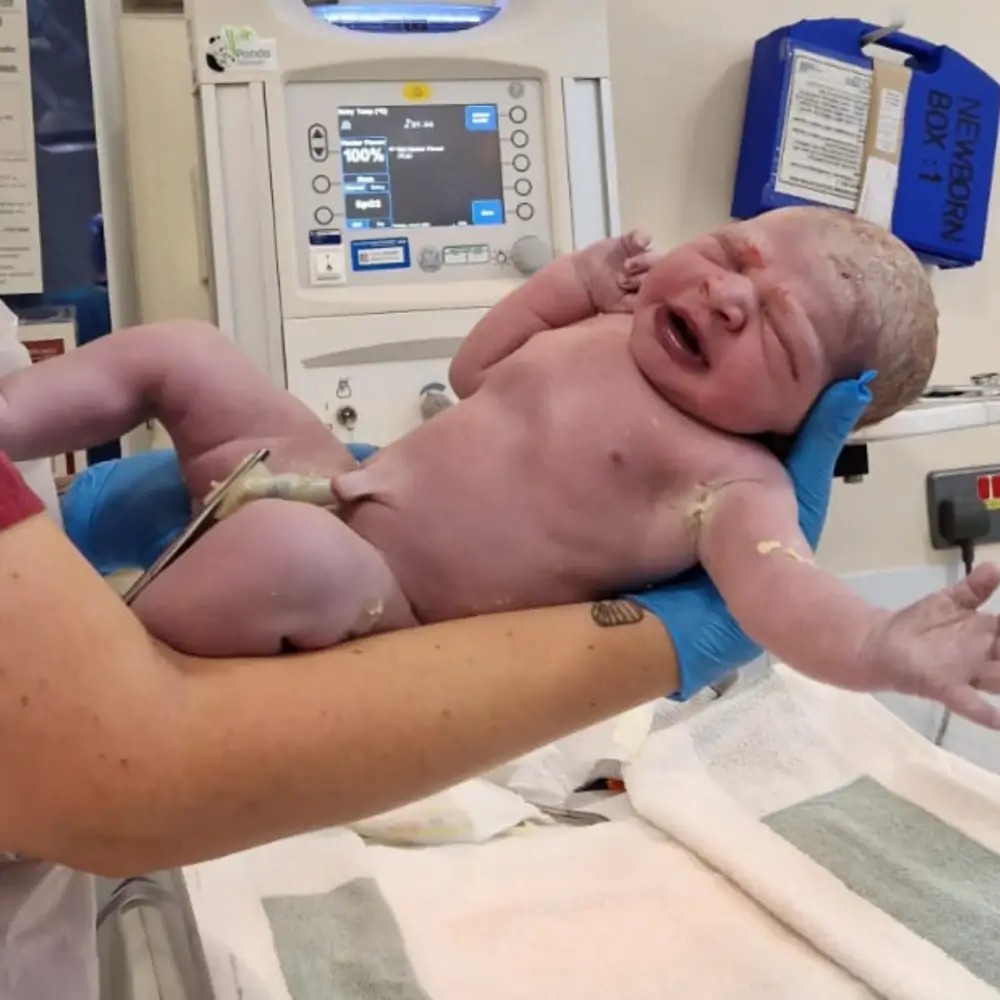
An empty bladder is a really important success factor for spontaneous separation of the placenta.
The structural closeness of the uterus and the bladder means that a full bladder can interfere with the normal uterine contractions required to expel the placenta.
After pains
Some cramping after birth is normal and it’s usually mild for first-time moms (if you feel them at all). But the cramps often get more intense with each future birth, and may be most uncomfortable after the second and third babies. This sometimes takes my clients by surprise as having birthed their baby they don’t expect to start up the cramp like contractions again.
Why do afterpains happen
Afterpains happen as your uterus contracts to return to its pre-pregnancy size and shape. This process is called “involution.”
Right after the birth of baby and placenta, your uterus weighs about 2 ½ pounds. By one week postpartum, it’s already half that size. And by about six weeks post-birth, it should be down to 2 ounces. (the size of a small pear)
Uterine cramping after birth serves another important purpose. It narrows blood vessels in the uterus to prevent excessive blood loss.
Breastfeeding can bring on postpartum cramping or make it more intense. That’s because your baby’s sucking triggers the release of the hormone oxytocin. This is the maternal hormone which causes contractions, and it has the same affects it did during birth. This is actually a good thing: The cramps help your uterus shrink back to normal size more quickly, reducing your risk of postpartum anaemia from blood loss.
Treatment for afterpains
A heat pad placed on the lower abdomen or applying your labour TENS to the area can help to soothe the discomfort as can simple painkillers like Paracetamol. If you have required some perineal stitches and have a registered professional present they can also offer you a suppository called Voltarol to help with pelvic pain and this is longer lasting but cannot be given if you are asthmatic.
What is a Retained placenta
Up to 3 women in every 100 are diagnosed with a retained placenta.
A retained placenta is when some or all of the placenta stays in your womb (uterus). It needs to be removed to prevent complications such as heavy bleeding.
You will be diagnosed with a retained placenta if it isn’t delivered in a certain amount of time.
The time will depend on which method of management you had.
Your doctor or midwife will diagnose retained placenta and discuss treatment options with you if all or part of the placenta remains in the womb after:
- 30 minutes of your baby’s birth if you have active management (More likely in consultant unit )
- 1 hour of your baby’s birth if you have physiological management (more likely in a midwifery led environment)
- During home birth if there is no active bleeding, the birth worker will create an environment to facilitate a physiological birth of the placenta without rigid time lines.
Giving the woman time and space for her body to produce more oxytocin and the contractions required to expel the placenta are important.
I have personally witnessed overzealous obstetric staff who have been involved with assisting the birth with forceps or vacuum extraction and whom within minutes of the birth start pulling on the umbilical cord to deliver the placenta, after clamping the cord early!
This is inappropriate and can lead to the cord snapping. This desire to rush rush rush the process may be because the labour ward is busy and their attention has been requested elsewhere.
It is fundamentally important to assert your preferences around delivery of the placenta and optimal cord clamping, particularly in a consultant unit during the hullabaloo that can be created around assisted birth and the number of attendant staff who suddenly appear in the room.
This drama filled episode in your birth can lead to trauma if not carefully managed.
Baby has just been born and is lying on your chest so adrenaline is high, your birth companions are emotional and the attendant staff just want to get on with things but be vigilant and don’t let things be “done to you’ unless you consent to them.
This is where your birth companions need to speak up and advocate for you.
Manual removal of placenta
There might come a point where it is obvious to you and your attendants that the placenta has not separated – this varies dependant upon your place of birth as mentioned previously.
You have breastfed baby, emptied your bladder and stood at the bedside or squatted on a bedpan or the toilet, you have been given time and space and the placenta has not released.
If you had a home birth, unfortunately this is one of the reasons it may become necessary for transfer into the unit. However, please ensure that you have tried to empty your bladder or asked the attendant professional to help you do this. There have been a number of times I have been present when a woman is taken to theatre to have her placenta delivered manually, and the cause of the retained placenta was a full bladder. It is really significant and frustrating as this could have been prevented with the correct management.
The womb can become tired after a long labour and contractions can become less effective after the baby is born. If you have not already had a synthetic oxytocin injection this will be suggested and if you are in hospital and a retained placenta is suspected a cannula (thin tube) will be inserted into a vein in your wrist to administer intravenous medication to stimulate contractions and control any bleeding
If this does not help to release the placenta then your midwife or doctor will talk to you about removing the placenta by hand (manually) in the labour room.
You will then be offered a vaginal examination to find out exactly where the placenta is. This can be painful, so you will be offered some pain relief, such as gas & air.
It involves the doctor inserting their hand into your vagina and in my experience of attending hundreds of births, unless you have an epidural in place it is very very uncomfortable indeed, in fact almost intolerable.
Tell the doctor to stop if this is the case for you or refuse to continue with the procedure.
If they cannot remove it by hand, you will be taken to an operating theatre where an obstetrician will remove the placenta once you have adequate pain relief .
The pain relief is generally a spinal anaesthetic – a small single dose of anaesthetic into the lower back, which numbs the body below the waist for around 4 hours, but you will be awake. If you already have an epidural in place, a top up dose of anaesthetic may be given
Your birth partner and newborn may be able to come with you to theatre if you want them to.
Your baby can stay with your birth partner if you do not want them to come with you, or there is a medical reason why they cannot come into theatre.
In my experience most couples agree that their birth companion will stay with baby in the recovery area whilst they go into theatre and usually once they have had their spinal injection they fall asleep due to the sheer relief of not having uncomfortable contractions any longer !
The operation happens manually, using the doctor’s hands. If the placenta is sitting in the cervix, your obstetrician can remove it, pulling it out through your vagina. If it is in your womb, they will detach the placenta from the wall with their fingers and gently pull it out.
There is a risk of infection, so you will be given antibiotics through the drip in your arm and prescribed oral antibiotics to take home with you.
You will be in theatre for under an hour generally, and you may experience a higher than average blood loss which will be monitored to ensure that you are stable before you go home
What happens to the placenta after birth?
In the first couple of hours after birth if you have an attendant health professional at your birth they will examine the placenta to check that all of the cotyledons (lobes) are present.
Each placenta typically is the size of a small dinner plate and the maternal side has 15-20 cotyledons which lay against the uterine wall in pregnancy and take blood from the maternal circulation filtering it through a branch like network of vessels which eventually form two arteries and a vein that supply life giving nutrients and oxygen to baby and remove waste products of respiration from baby.
The placenta is examined to ensure that all cotyledons look to be present and that any raw areas that look incomplete might signify that a lobe has been retained which can lead to increased bleeding or infection if not managed. (this is very rare in my experience.)
The attendant professional will also examine the amniotic sac where baby has been nestled for almost 10 months and will note whether there is a single opening where the bag of waters released or whether the membranes appear ragged, which again needs to be noted in case some membrane is left in the uterus as we would anticipate slightly heavier bleeding until this is passed.
Lotus birth
A lotus birth, also known as umbilical non-severance or umbilical non-cutting, is a childbirth practice where the umbilical cord is not clamped or cut immediately after the baby is born.
Instead, the cord and placenta are allowed to detach naturally from the baby’s belly button over a period of days, typically until the cord dries up and falls off on its own.
This practice is rooted in some traditional and holistic approaches to childbirth and is seen as a way to promote a gentle and non-invasive transition for the newborn into the outside world.
Here’s how a lotus birth typically works:
- After the baby is born, the umbilical cord is not cut or clamped. It remains attached to the baby at the belly button and falls off around 5 days later
- The placenta is usually placed in a special bag or container to keep it clean and prevent contamination and holistic practitioners use herbs and salt to help the placenta to dry up and to reduce odour
- Over the next few days, the umbilical cord naturally dries up and shrivels. Eventually, it detaches from the baby’s belly button.
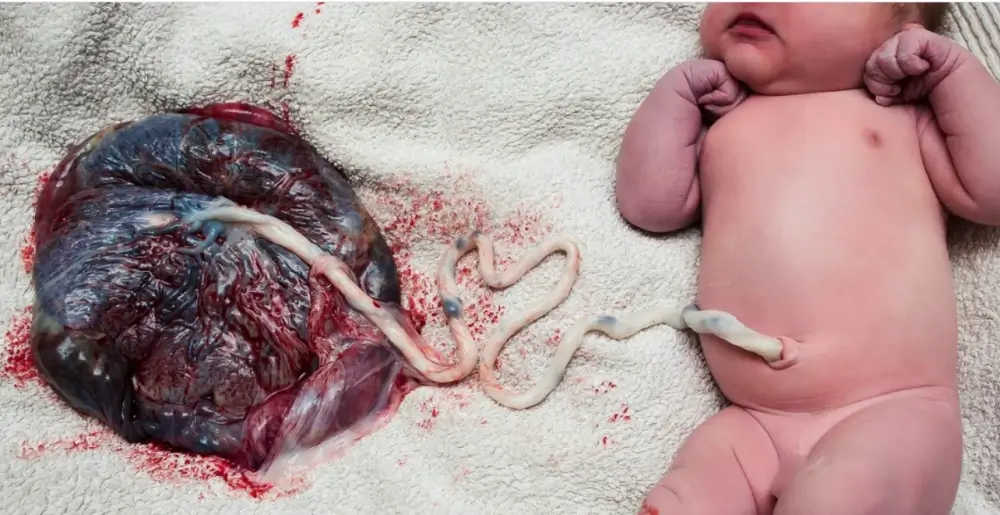
Since there’s no solid research on lotus birth, it’s unclear if the practice is actually beneficial. It could be that optimal cord clamping provides all the post-birth benefits from the placenta and that nothing beyond that is necessary. (see below)
Proponents of lotus birth believe it may lower the risk of infections because it does not cause an injury to the cord. However, it can also increase the risk of infection because, after birth, the placenta is a dead organ containing stagnant blood. There’s not enough research to say how much higher the risk of infection may be with a lotus birth.
Lotus birth can also be a spiritual practice to honour the relationship between the infant and its placenta. If you want to honour the placenta but aren’t sure if lotus birth is right for you, there are other rituals you can use, like burying it in a special ceremony. Indeed the Maori people give it a ritual burial believing it binds the child to its ancestral land and people, or you may wish to bury it and plant a tree on top so the tree grows as your child grows. You may have to wait a year after to plant the tree as the high iron levels in the placenta can kill off new plants.
If you wish to take the placenta home with you following a hospital birth you will need to bring in your own container and the hospital will provide guidelines on safe disposal/burial. Pop it into your freezer whilst making your mind up about what to do with it.
Cord burning ceremony
The process of using heat (flame from a beeswax candle, usually) to sever the baby’s cord as opposed to clamping and cutting it
So here’s the process. After the placenta has been delivered, the baby is snuggled skin-to-skin on mother’s chest with the cord intact and still attached to the placenta. Then, a homemade “shield” made of aluminum foil-covered cardboard is placed around the cord with the aluminum foil facing the placenta. The cord is held over a candle flame and rotated for 10-15 minutes until it burns through and separates. The attendant companions can gently twist the cord to help this process.

Many people love the idea of being the one to cut the cord. Should the partner be the one to do the honour? An older child if there is one? Does the mother want to do it herself to draw the end to giving birth completely? In the photo above the hands of the midwife and father are also in there. A special memory is being created with cord burning, where the whole family can be involved.
After the end of the cord has cooled, the half of the cord that’s attached to the baby will be curled into a spiral or tied into a knot on the baby’s stomach and wrapped with gauze until the next day. When the gauze is removed, the cord spiral or knot will air-dry and is likely to fall off just a few days later.
You may be asking what the benefits of cord burning are ?
If you’ve had a baby, think back to the first hour after your baby was born. It’s often called the “Golden Hour” in which the new family is (supposedly) peaceful, calm, and falling in love with their newborn. However, it often seems like it’s all business – the business of clamping and cutting the cord, expelling the placenta, and basically rushing the separation of the baby from all it’s ever known into this new, cold, bright, loud world.
I like to think of cord burning as a refreshing way to slow it all down. It’s a very intentional way to allow families to savour the connection of the baby to the mother’s body, rather than blindly running forward into this newness, although it does smell a bit so do ventilate the room during the process !
Also, consider your clan. Cord burning can be a way for the partner, doula, midwife, and even the baby’s older siblings to be involved in the baby’s birth. What a beautiful way for a baby to be introduced to their community!
Medically speaking, cord burning can be a great way to separate the cord when there aren’t sterile medical supplies available – clamps and scissors. There are also known physical benefits to optimal cord clamping, which necessarily precedes cord burning.
Cord burning may not be for everyone. In fact, the way it stands, it’s currently just an option for home birth babies since hospitals don’t allow an open flame in the birth rooms. But now you know there’s another option for you to consider as you plan out your ideal “Golden Hour.”
Placentophagy
Eating your placenta is called placentophagy, and it is considered a survival instinct for over 4000 species of mammals.
One reason why animals eat their placenta is that it gives them nourishment, especially at a time when they need to feed their young and can’t leave them to look for food.
Another explanation is that it keeps the birthing den clean to avoid attracting predators.
Because humans live in social groups, birthing mothers do not have to eat their placenta in order to defend themselves against predators or forage for food.
Placentophagy advocates claim that the placenta contains nutrients that can prevent postpartum depression, reduce postpartum bleeding, boost energy levels, improve milk supply, and provide essential vitamins.
It is important to note that currently, there are no scientific studies to confirm or refute these claims. Much of the reported benefits are anecdotal.
The placenta can be consumed raw, cooked, as a smoothie, or encapsulated in pill form or formulated into a body balm.
It can also be turned into a piece of art as the smooth side that lay next to baby in the womb has an intricate web of vessels that resemble the branches of a tree.
Placenta prints can be made and framed as a keepsake.
Some home birth workers keep this simple and make a placental imprint on a plain piece of photocopying paper which can be allowed to dry before framing it.
Placental encapsulation
The nutritional value of encapsulated placenta pills is dubious because only a few nutrients remain at the end of the process.
Cooked placenta offers protein, but the heat of cooking breaks down the hormones that are claimed to help the mother during the postpartum period.
The only way to really absorb all the nutrients in the placenta is to eat it raw, which many mothers find gross.
If you want to find out more about this procedure you can find a practitioner online and ask for the evidence.
Optimal cord clamping
Optimal cord clamping is an essential aspect of the third stage of labour, regardless of the chosen management approach. It involves not agreeing to the clamping and cutting of the umbilical cord, ideally until it turns white, to ensure that the transfer of blood from the placenta to the baby is completed.

Going back to early obstetric textbooks in the 1930’s there was mention of not clamping and cutting the cord for a few minutes after birth.
When I qualified as a midwife in 1989, I remember my mentor scrambling to administer a synthetic oxytocin injection into our patients thigh before clamping and cutting the cord, leaving all that health enhancing blood remaining in the cord and placenta to be simply thrown out.
Green top guidelines from the UK Royal college of Obstetricians and gynaecologists suggest clamping and cutting the cord at 1 minute during caesarean birth due to the fact that whilst the abdomen is open the bleeding presents a risk to mothers, however this can be managed with tying off vessels and cauterising them and it is not always necessary to clamp the cord after 1 minute whilst it still has lots of baby’s blood within it.
I have been in theatre many times when the baby is placed on mothers abdomen during surgery and the team have waited for several minutes if all is well.
This guidance of waiting 1 minute before the cord is clamped and cut has trickled down into labour ward practice whereby when obstetric staff are assisting birth they will often unceremoniously clamp and cut the cord at one minute without consent.
In fact when this happened at a recent birth I attended I expressed my horror and disapproval and the attendant midwife actually stated “ there is no benefit after one minute”.
THIS MUST STOP .
Unless there is a very good clinical reason to clamp the cord early.
The benefits of delaying the clamping, now known as Optimal cord clamping, are massive
Benefits include:
- Increased Iron Stores: Optimal cord clamping allows the baby to receive more iron-rich blood from the placenta, reducing the risk of iron deficiency and anaemia in infancy.
- Improved Cardiovascular Health: The additional blood transfer helps establish a more stable cardiovascular system in the newborn.
- Enhanced Immunity: The extra blood contains important immune factors that can boost the baby’s immune system in the early days of life.
- Better Brain Development: The additional blood flow to the baby’s brain may support optimal brain development.
Stem cell Transfer
One of the major benefits of not rushing to clamp and cut the umbilical cord are in the significant stem cell transfer that occurs once baby is born and is still attached to the cord.
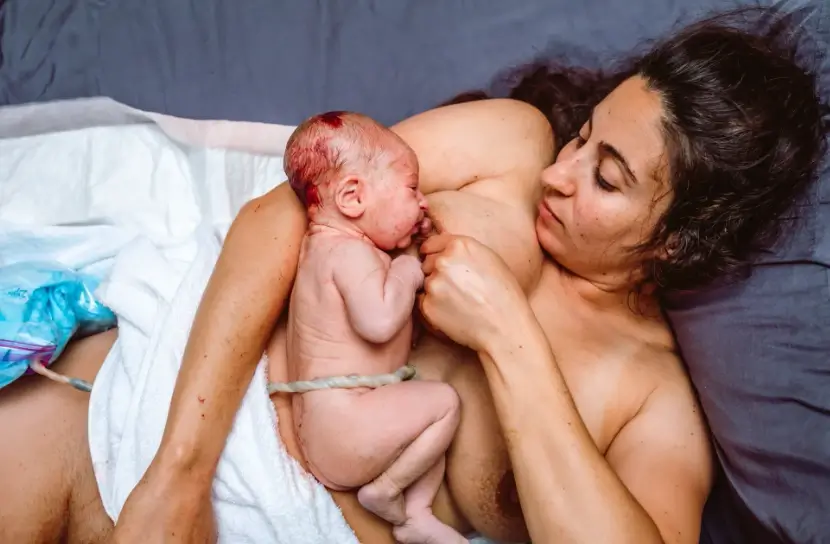
Stem cells are a unique type of primitive cell with the remarkable ability to develop into many different cell types within the body. They are often described as “undifferentiated” or “unspecialised” cells because they have not yet committed to a specific function.
Stem cells can divide and produce both identical stem cells and specialised cells with specific functions in other words they are essential for repair and can differentiate into whatever tissue is needed for that to happen e.g bone, brain, heart tissue
The placental and umbilical cord contracting with blood pumping toward the newborn during birth results in the first natural stem cell transplant. The newborn is deprived of both the blood volume and stem cells that he/she could have received if the umbilical cord was clamped and cut too soon.
This intentional loss of stem cells at birth through clamping and cutting the cord too early, is thought to predispose infants to diseases like chronic lung disease, asthma, diabetes, cerebral palsy, infection, and cancer. Furthermore, it is argued that if the birth process is traumatic for the infants, it is possible for stem cells to help in recovery, so the campaign to resuscitate babies on mothers abdomen whilst the cord is still attached needs to be supported as currently the rush to clamp and cut the cord and rush baby to the resuscitaire (special cot with heat and light ) is not the optimal approach.
In premature babies optimal cord clamping actually saves lives.
This is not a theory it is actually proven and the fantastic work of Hannah Tizzard in her ‘Blood to Baby’ campaign is worth reading and supporting
So what is the optimal length of time to leave the cord unclamped, if you wish to have it cut at all!
For me, if I’m supporting a woman giving birth in a hospital it’s when the cord has stopped pulsating, as an absolute minimum, you can feel this with you fingers.
At a home birth with lights down, gentle music playing and an unhurried transition to life as a newborn, I have never clock watched as nature has released the placenta just as it should.
Cord blood for PH measurement after assisted or Caesarean birth
After a challenging labour which concluded in assisted or caesarean birth , the attendant obstetrician will ask the midwife to take blood from the cord to determine how stressed baby has been in labour, and this is tested for fetal PH and lactate. This is preceded by the cord being clamped before baby has received all of their blood .
Remember this is BABY’s blood not CORD blood.
This will be suggested for medico-legal reasons in case baby is later found to have a problem related to care provided during labour and birth.
This is a dilemma because if baby is born crying robustly then this test might not be needed and if baby does need some assistance to breathe then early cutting of the cord is detrimental as this disrupts the blood flow to and from the placenta when baby is transitioning to newborn breathing via their lungs so this could make matters worse.
It’s important to state loudly that “no blood letting or clamping or cutting of the cord should take place” unless you are informed and agree to it.
Cord blood for stem cell collection
Private companies are advertising the benefits of retrieving blood from the umbilical cord and placenta at birth and collecting it for stem cell storage. This is an expensive process with initial financial outlay plus a monthly cost for ongoing storage. Although this has been offered for many years I have yet to read about many baby’s who have benefitted from having their own stem cells collected and later returned to their body if they develop an illness throughout life.
There is a fantastic podcast episode that explains more about this from an obstetric consultant point of view that you may find useful.
One of the key points for me is that when collecting cord blood for stem cell collection they need a minimum of 60mls but they can achieve up to 150mls. This is your baby’s blood and is the equivalent volume of a small pot of dairy cream. My belief is that baby will have more benefit from this precious blood at birth and in the first 6 months of life and beyond than having it collected and stored just in case of a problem later in life .
How do I write my preferences about the third stage of labour on my birth plan
Here’s a few ideas
– I need privacy and time to birth my placenta
– I want you to wait for the cord to stopping pulsating before it is clamped
– Do not clamp my baby’s umbilical cord at 1 minute
– I Do not consent to you cutting the cord until i have given my express permission for this
– If you are in a hurry to attend to another woman after assisting my baby’s, birth remove my legs from the lithotomy stirrups and cover me in warm blankets so that I feel safe and can feed my baby to encourage my placenta to separate
– If I am bleeding from an episiotomy wound or tear please apply a compress and assist me with bringing my thighs together to stem the bleeding if this is appropriate so i can have time for my placenta to separate.
– Please wait for signs of placental separation.
– Do not vigorously massage my abdomen please be gentle and ensure I have effective pain relief
– Please assist me with latching baby at my breast to help my body produce more oxytocin and expel the placenta.
– Please assist me with emptying my bladder – provide a bedpan or help me to the toilet or to stand/squat at the bedside as gravity helps.
– I am happy/unhappy about having a catheter (thin tube), inserted into my bladder to release any urine if my blood loss is heavy or the placenta has not released and ONLY with full consent so that I can make an informed decision.
– I do not consent to a manual removal of clots or placenta in the room without adequate pain relief, and if I ask you to stop I mean it !
– I do /do not want my baby and birth companion to come into theatre with me for this procedure If my partner stays in the recovery area with our baby, please keep him updated if the procedure becomes more complex to keep him informed.
– I do/do not consent to cord blood sampling after an assisted birth or caesarean if baby is born in good condition.
– After my home birth I would like to use cord burning instead of clamping and cutting the cord
-I do not consent to the cord being clamped and cut as I’m looking to achieve a lotus birth.
Conclusion
The third stage of labour is an important part of the childbirth process that maybe does not get the consideration it needs during antenatal classes and birth planning discussions.
Over the past 50 years medical practitioners, including doctors and midwives, have typically followed the routine practice of promptly clamping and severing the umbilical cord without any substantial evidence to suggest that the timing of this procedure has a significant impact.
However, recent findings have indicated the advantages of delaying, optimising, cord clamping. Early cord clamping occurs when the cord is cut before 60 seconds post-birth. Ideally, the cord should remain uncut until it has ceased pulsating, indicating the completion of the blood flow from the placenta to the newborn.
Allowing the cord to remain attached for as long as possible not only ensures that the baby receives additional blood but also has the potential to increase birth weight, enhance the baby’s blood volume by up to a third, and boost the baby’s iron reserves for up to six months.
Research has shown that the transfer of blood from the placenta is largely completed within three minutes.
Iron deficiency anaemia, the most severe form of iron deficiency, affects approximately 25% of preschool children worldwide and 3-7% of the European population. This deficiency can have long-lasting effects on a child’s brain development.
The solution lies in maintaining the attachment of the baby to the cord for as long as possible to ensure a substantial reserve of iron for the baby’s future needs.
By allowing nature to take its intended course and delaying (optimising ) the clamping and cutting of the cord, both mother and baby remain connected, preventing anyone from separating you. Everything that a midwife or paediatrician needs to do can be accomplished with your baby in your arms, with skin-to-skin contact.
This is a moment that can never be taken away from you, and it also promotes positive outcomes for your baby.
If you would like to join me for a personal birth planning session where we can outline your choices and options to bring you closer to achieving the birth you want on your terms then please book in here.
Linda Lilwall is an independent Midwife and birth educator with nearly 4 decades of experience
Note: The information in this article is not designed to replace medical advice based upon your individual need


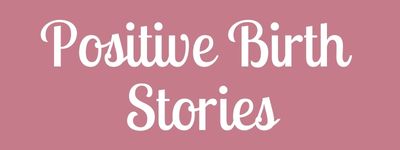

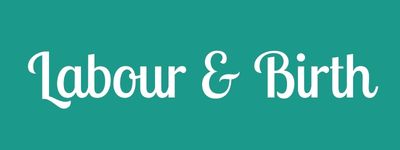
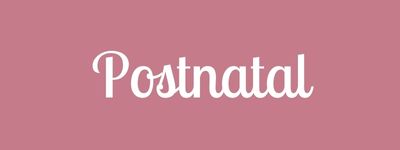

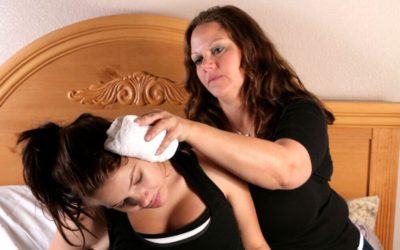
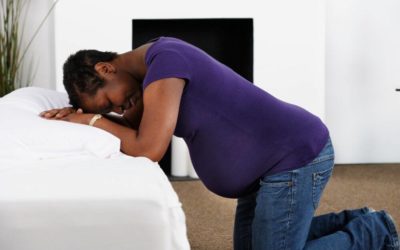
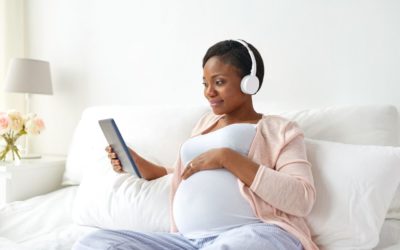
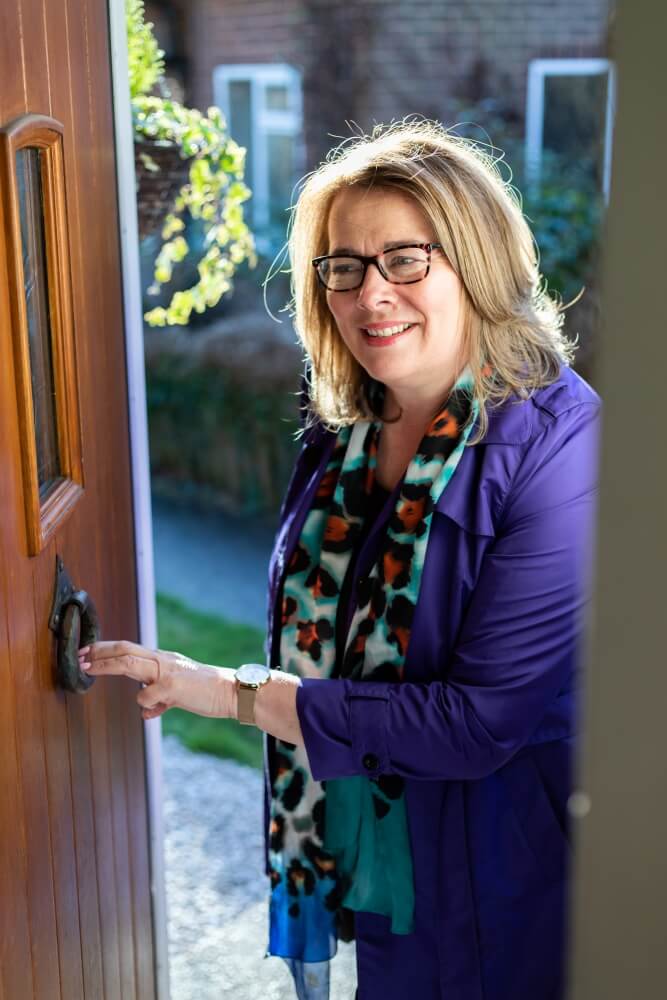
0 Comments